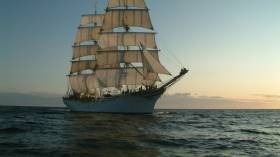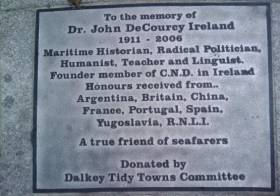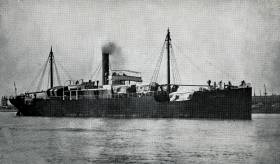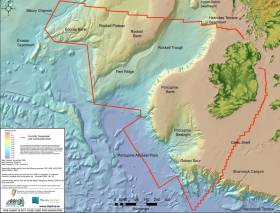Displaying items by tag: Afloat Calender Dates
#HeritageWeek – As part of Heritage Week events, Norwegian tallship, Statsraad Lehmkuhl will be open today, Saturday, 20 August at Sir John Rogerson’s Quay, Dublin, with 'shanty' singing sailors between 2 and 4pm. No booking required nor admission fee.
In addition to the nautical theme, an exhibition to capture the history of Dublin Docks and surrounding dockland communities for the period 1960 to 1973, is to be held in Dublin next week.
The exhibition will feature photographs, memorabilia and copies of the Waterfront News, which was a unique publication/newspaper, that not only captured what was going on in Dublin Docks and the dockland communities but gave a flavour of what was going on in Irish society at that time.
The exhibition organised by Dublin Dock Workers Preservation Society will be held at Dublin City Council Civic Offices on Wood Quay.
Opening dates are from Monday 22 to Friday 26 August, and times are between 09.00 – 17.00. No booking is required nor admission fee.
Further exhibition details:
Suitable for Children: No
Wheelchair Access: Full
Car parking Available: No
Indoor/Outdoor: Indoor
Organiser Details website: www.bluemelon.com/alanmartin
#LectureTributeDrIreland - The final of the 1916 Easter Rising maritime themed lectures held to commemorate the centenary takes place next week in the National Maritime Museum of Ireland in Dun Laoghaire.
The lecture programme with the support of Dun Laoghaire Rathdown County Council culminates next Thursday, 9 June with the talk: Dr. John de Courcy Ireland - A tribute to a Maritime Historian.
John Ellis who is to present the free lecture beginning at 7.30, was a pupil and close friend of Dr John de Courcy Ireland. Ellis will pay tribute to the noted maritime historian whose seminal work on the maritime aspects of the Easter Rising opened up this hitherto little researched field for future historians.
A special centenary version of Dr. Ireland's 'The Sea and the 1916 Easter Rising' is available to buy from stockists including the musuem's souvenir and gift shop.
The book when first published was commissioned by the state on the occasion of the 50th anniversary of the Rising in 1966. Funding for that edition was provided by Irish Shipping Ltd.
Lecture: ‘Maritime Aspects of the 1916 Rising’
#1916maritime - The Winter lecture 2015/16 season of the Glenua Sailing Centre concludes with a lecture entitled: ‘Maritme Aspects of the 1916 Rising’ by Dr Edward Bourke.
The illustrated lectures will take place on Thursday 14 April (20:00hrs) at the Poolbeg Yacht & Boat Club, Ringsend, Dublin. There will be an entry fee of €5 in aid of the R.N.L.I.
Edward Bourke is an industrial microbiologist recently retired from brewery research. He is also maritime historian and has published five books on Irish shipwrecks as well as a history of Guinness. Currently he is working on the role of intelligence during the war of Independence in Ireland.
In his illustrated lecture, Edward will explore several maritime aspects of the 1916 events. Foremost among them being the role played by the Royal Navy in suppressing The Rising by strategic interventions.
He will assess the view that the impact of the Helga is greatly exaggerated on the basis that most of the shelling of Dublin was done by field artillery or whether the import of guns for the Volunteers in 1914 was carefully controlled by the British authorities. How plausible is the opinion that the navy had ample forewarning of the intentions of the Volunteers but allowed the 1916 Rising to proceed?
Edward will also discuss the significance of the 1916 rising in the wider context of the Great European War.
#1916Lectures – On this centenary of the 1916 Easter Rising, a series of lectures themed on the lesser known maritime aspects of the rising continue to be held at the National Maritime Museum of Ireland.
The second of the seven free talks running to June, will be presented by Dr. John Treacy on the topic: The Silent Shore, The AUD, Roger Casement and Banna Strand.
The lecture takes place on Tuesday, 5 April (7.30 to 9:30 pm). The lecture will trace the story of the Aud from its departure from Lubeck to its scuttling off the Daunt Rock, plus the ill-fated landing of Roger Casement from U-19 on Banna Strand.
Dr. John Treacy has previously lectured extensively on the development of the modern Irish Naval Service.
The NMMI's commemoration of the Rising is supported by Dun Laoghaire Rathdown County Council and the Ireland 1916 – 2016 Centenary Programme.
Also running at the museum is a specially produced 1916 Rising exhibition held in the former Mariners Church which houses the maritime museum.
Double Lecture: ‘The Sea From Two Perspectives’
#DoubleLecture - The Winter lecture 2015/16 season of the Glenua Sailing Centre continues with a double lecture programme at the March meeting entitled: ‘The Sea From Two Perspectives’.
The illustrated lectures will take place on Thursday 3 March (20:00hrs) at the Poolbeg Yacht & Boat Club, Ringsend, Dublin. There will be an entry fee of €5 in aid of the R.N.L.I
The first lecture, “Art and The Sea-An Enduring Fascination” will be given by Jessica O’Donnell who is Collections Curator at Dublin City Gallery The Hugh Lane. She is a graduate of Trinity College, Dublin and the University of St Andrews. Her publications include Discover Art (shortlisted for CBI Children’s Book of the Year in 2008) and Harry Clarke The Eve of St Agnes (2012). She also enjoys sailing and is a member of Sailing in Dublin (SID) Club.
The talk will explore how artists have been captivated by the sea from many perspectives including how the Impressionists loved portraying people at leisure by the sea; how safeguarding the freedom of the seas was represented in artworks commissioned as war time propaganda; to contemporary artists whose fascination with the sea and marine life continues to inspire.
The second lecture is entitled, “Putting Eyes In The Deep Ocean” by Dr Fiona Grant, Ocean Science & Information Services (OSIS), Marine Institute, Ireland. Fiona began her studies in geology before going on to specialise in marine geophysics and earth system dynamics.
Her first job was as conservation coordinator for wild salmon and sea trout before taking responsibility for research infrastructures in the Marine Institute.
The talk will focus on some of the challenges in observing the deep ocean environment, how to harness ocean energy in Galway Bay and present some of the latest results from studies in the Atlantic Ocean
1916 Lectures & Exhibition Commemorates Easter Rising
#1916Lectures – A series of 1916 Easter Rising themed lectures on the lesser known maritime aspects of the rising accompanied by a specially produced exhibition will be held in the National Maritime Museum of Ireland, Dun Laoghaire.
As its contribution to the 1916 commemorations, supported by Dun Laoghaire Rathdown County Council and the Ireland 1916 – 2016 Centenary Programme, the Maritime Institute of Ireland (founders of the NMMI) is presenting seven lectures at the museum venue located in the Old Mariners Church, which is only minutes away from the DART and off Dun Laoghaire’s main street.
1916 Exhibition: The exhibition will tell the story of the 1916 Rising from a maritime viewpoint and is to include a display of a gun from the Asgard and a map showing the Helga's movements in 1916.
1916 Lectures: The maritime dimension to the Easter Rising commenced in 1914 and two lectures will examine the role of the Asgard and the lesser known yacht Kelpie in running arms to the Irish Volunteers into Howth and Kilcoole.
The story of the Aud from its departure from Lubeck to its scuttling off the Daunt Rock, plus the ill-fated landing of Roger Casement from U-19 on Banna Strand and the shelling by the Dun Laoghaire based HMS Helga of Boland’s Mill and Liberty Hall during the Rising will be the focus of two further lectures.
The working conditions of Seamen and the prevailing social divisions between Kingston/Dun Laoghaire seafarers in 1916 will also be explored.
Concluding the series will be a tribute to the immense contribution of the noted historian Dr John de Courcy Ireland to the little known maritime history of the Rising when he first penned ‘The Sea and the Easter Rising 1916’.
The publication was timed for the 50th anniversary of this historic event which heralded the birth of the new Irish Nation.
Inaugural 1916 Lecture: ASGARD on the Road to the Rising and Beyond, will be held on 15th March (7:30 pm - 9:30 pm)
The presenter, Pat Murphy a well-known yachtsman who has broadcast extensively on RTE Radio One’s maritime programme ‘Seascapes’ explores the role of the Asgard in the run up to the Rising.
Below is a list of the following lectures
April
The Silent Shore, The AUD, Roger Casement and Banna Strand – 5th April (7:30 pm - 9:30 pm)
The AUD and the HELGA in the 1916 Rising – 26th April (7:30 pm - 9:30 pm)
May
Working Conditions of Seamen in 1916 – 12th May (7:30 pm - 9:30 pm)
Conor O'Brien, KELPIE and the 1914 Gun Running – 19th May (7:30 pm - 9:30 pm)
Kingstown: A Divided Seafaring Town – 26th May (7:30 pm - 9:30 pm)
June
Dr John de Courcy Ireland: A Tribute to a Maritime Historian – 9th June (7:30 pm - 9:30 pm)
Further information on opening exhibition times and updates are available from the NMMI website: www.mariner.ie
To contact: Tel: (01) 214 3964 and by email: [email protected]
Lecture: ‘George Forbes –Longford’s Forgotten Admiral’
#Lecture - The Winter lecture season of the Glenua Sailing Centre continues with the February lecture, ‘George Forbes –Longford’s Forgotten Admiral’.
The illustrated lecture to be presented by Joe Varley next Thursday 4th February (20:00hrs) takes place at the Poolbeg Yacht & Boat Club, Ringsend, Dublin. There will be an entry fee of €5 in aid of the R.N.L.I.
Joe has a reputation for being an engaging and entertaining lecturer. With a passion for the sea from his seagoing experience as a radio officer and his time as a sailing instructor with Glenans, Joe is now active as a maritime researcher. In addition as a volunteer with the Maritime Institute of Ireland which has its premises at the National Maritime Museum of Ireland in Dun Laoghaire.
His illustrated presentation on the colourful life and remarkable achievements of George Forbes, 3rd Earl of Granard, will reveal a neglected naval tradition in the quiet Longford village of Newtownforbes where Forbes was born in 1685.
Forbes was a Royal Navy commander, diplomat and politician who held posts of high distinction throughout Europe. He went to sea at a young age and was present at some of the most significant events of his age, including the Capture of Gibraltar in 1704. He acted as advisor for the Holy Roman Emperor, Charles VI, in the foundation of the short-lived Austrian navy. Similarly, in 1734, while on a trade visit to Russia, he was invited to assist in the development of the Russian Navy. On his retirement from the Royal Navy, he returned to Newtownforbes where he lived until his death in 1785.
#Lecture - The Winter lecture 2015/16 season of the Glenua Sailing Centre continues with this year’s first lecture, ‘Solo from Brittany to Guadeloupe The Story of the Mini-Transat 2015’.
Tom Dolan will present an illustrated lecture on Thursday 21 January (20:00hrs) at the Poolbeg Yacht & Boat Club, Ringsend, Dublin. There will be an entry fee of €5 in aid of the R.N.L.I.
So what a year 2015 has been for Tom! Just twelve months ago on a wet and windy Thursday night at the Ringsend venue, he gave a short presentation to Glenua members and friends on his bid to race alone in a 6.5m boat for 4,000 miles in the Mini Transat 2015 from Brittany to the Caribbean.
This race began on 19 September and Tom promised he would report back to Poolbeg in January 2016!
Tom’s rapid progression in the Glenans Irish Sailing School from volunteer to sailing instructor, to sailing centre manager in Ireland and France and his passion for the sea, earned him an enviable reputation in the sail training world. However, below the radar, so to speak, was an increasing engagement with the challenges of ocean racing. Apart from the expense of equipping his borrowed boat, he was on a steep race-training curve and very much “a rookie”!. However, after 3,000 miles training and racing, he qualified for the Transat and secured 10th in the rankings.
From then on, it was downwind all the way to Guadeloupe via Lanzarote in the fastest ever Transat.
After two and a half weeks alone at sea, the final result for Tom was 22nd out of 46 starting yachts, less than 20 minutes off the top twenty.
The story behind that fine achievement is what Tom will tell in next week’s presentation and which is to include a Q & A session.
Annual National Commemorative Services for Irish Seafarers
#SeafarersCommemorations -The Maritime Institute of Ireland which organises the annual Dublin Ecumenical Memorial Commemoration Service for seamen lost at sea will be held this Sunday, 15th November.
A second service takes place in Cork the following weekend, see details below.
Dublin Services
The service this Sunday is take place at 12.30 in the Church of the Immaculate Heart of Mary, City Quay, Dublin 2 which is located close to both Pearse and Tara Street DART and suburban railway service stations.
The annual commemoration also involves tributes paid by organisations laying wreaths from both north and south of this island to all seafarers lost on Merchant ships during WW2. This takes place at the Irish Seaman’s National Memorial also located on City Quay.
Light refreshments will be available during this occasion. After a break for lunch the company will reassemble for Evensong at 3.15 held in St. Patrick's Cathedral.
Cork Service
On the following weekend, the annual Cork Ecumenical Memorial Commemoration Service for seamen lost at sea will take place in the Board Room of the Port of Cork Company’s offices, Custom House Quay, Cork on Sunday, 29th November at 1200 noon.
The Martime Institute it should be noted also has the National Maritime Museum of Ireland on Haigh Terrace, Dun Laoghaire. For more details on museum times, what to see and events visit here.
Lecture: Kish Lighthouse-Before the Build
#KishLight@50 – In celebration of the 50th Anniversary of the Kish Lighthouse off Dublin Bay, the National Maritime Museum of Ireland in Dun Laoghaire is host to a lecture about what is one of Ireland’s most famous and unique lighthouses.
The impressive 12-storey structure of the lighthouse (towering 31 metres high when in situ) was constructed five decades ago in Dun Laoghaire Harbour.
Tugs brought out the 'floating' 7,000 tonnes lighthouse in the summer of 1965 to the the Kish Bank from where it was sunk into position on the sandbank. It was not until November 9th that year that the light was first exhibited having replaced a lightship.
To hear more on the details of how the lighthouse was built, a two-hour lecture takes place in the NMMI this Thursday, 12 November. The lecture “Kish Lighthouse –Before the Build” begins at 8pm and will be co-presented by Brian Kelly and Eoghan Lehane.
Tickets cost €10.00 and for more details including an exhibition held in the NMMI click here.
In addition the RTE Archives has a link, click here for the ‘Newsbeat’ programme from 1965 on the construction of the lighthouse.

































































